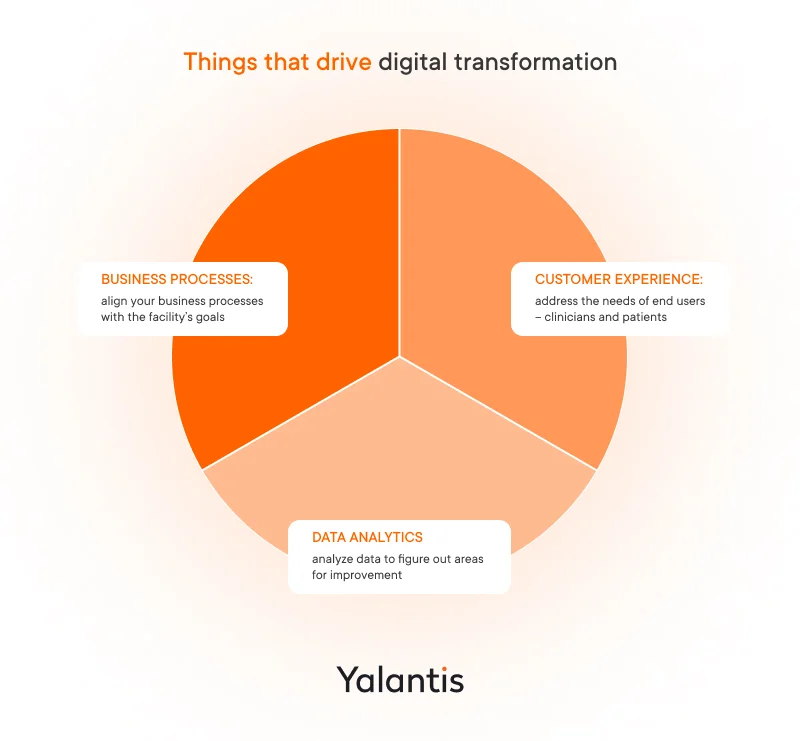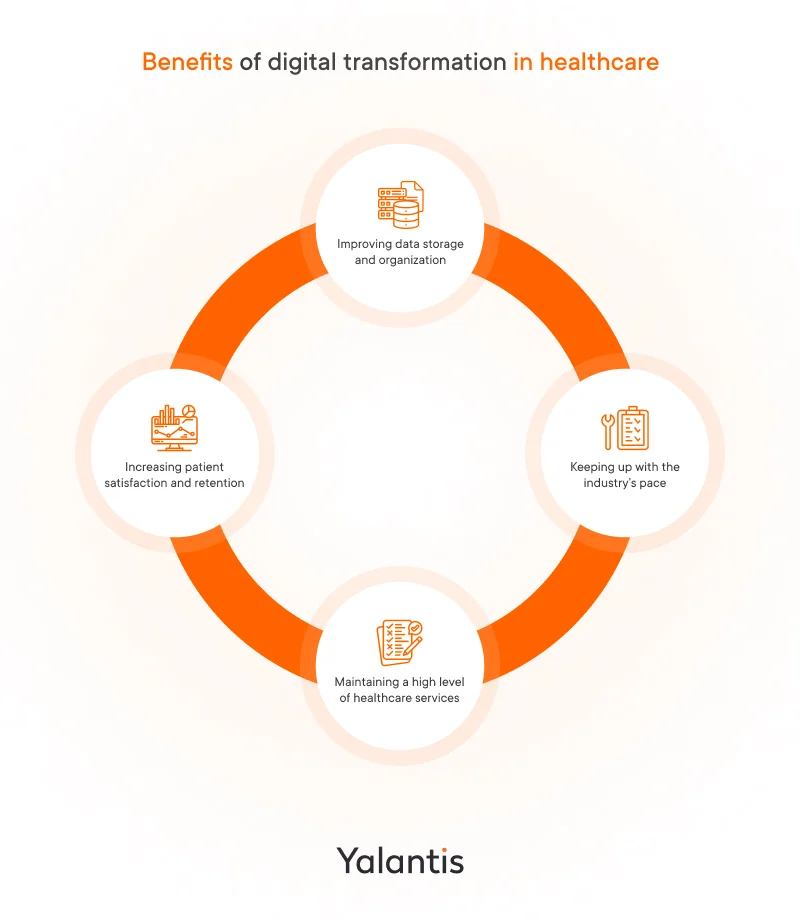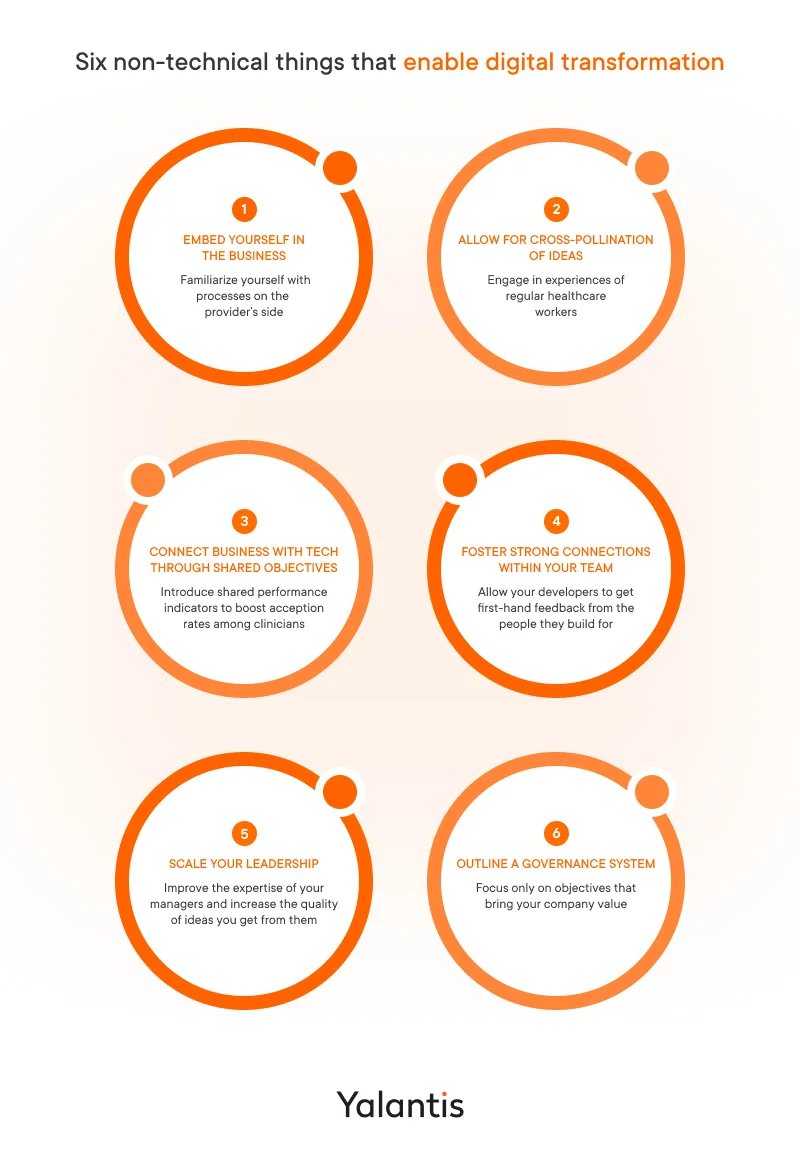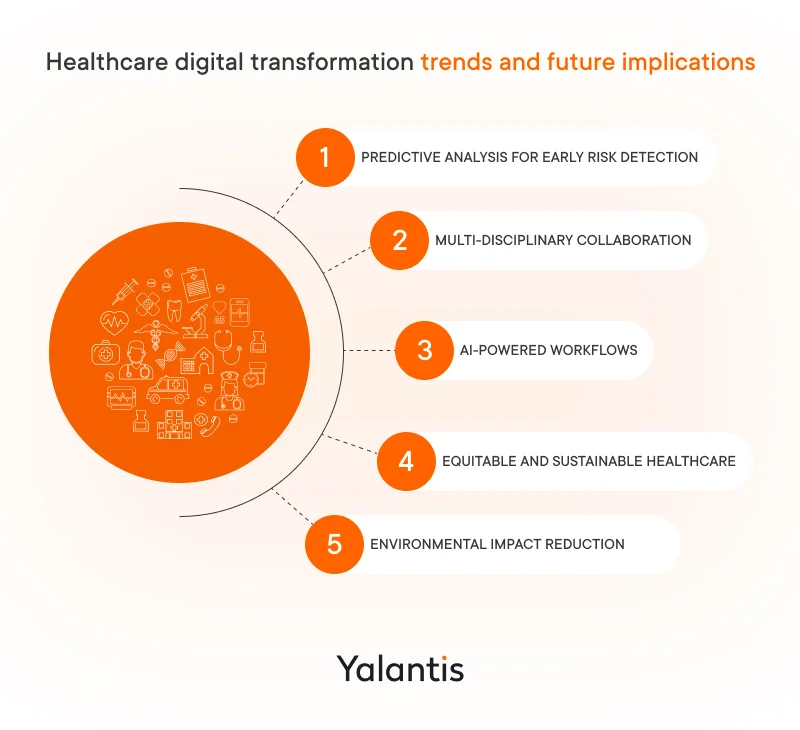
Digital transformation in healthcare: roadmap for achieving long-term success
Summarize:
Digital health solutions have been adopted by over 80 percent of consumers according to a 2022 survey of 8,014 respondents by Rock Health. Moreover, telehealth services are now accessible to groups that have previously been underserved by healthcare providers, including elderly people, people living in rural areas, and people without insurance.
However, despite these hopeful insights, the healthcare industry itself remains a few years behind the newest trends. This opinion was voiced by Edward Marx and Simon Jones, guests at Yalantis’ recent online event who are experts in digitally enabled healthcare transformation and our long-time partners.
This prompts the following questions: What are the necessary steps and success factors for digital transformation in healthcare and what happens after you implement new technology? How can you facilitate the shift towards digital services and make it comfortable for all parties involved – doctors, patients, and technology teams?
Today, we’ll explore:
- the steps to take before and during digital transformation
- build vs. buy approaches to software development
- how to make clinician teams more accepting of new technologies
- how Yalantis can help you handle digital transformation for your healthcare facilities
We will also share key points on how to make the process of adopting, using, and maintaining your new digital environment smooth and help you make informed decisions.
What is digital transformation in healthcare?
First, let’s see what defines the process of digital transformation in the healthcare market. Here’s what Edward Marx has to say:
“There’s no perfect definition of digital transformation, but for me, it’s about three things: business processes, customer experience, and data analytics.”

Yalantis experts completely agree with Edward’s perspective and want to expand on each aspect:
- Business processes. You need to align the objectives of your healthcare business with the goals you need to achieve for a given facility. This means connecting with end users of your solution and addressing their needs. A comprehensive business strategy should consider processes like error-proofing, automation, data governance (data governance models), and scalability.
- Customer experience. Your customers are healthcare professionals and patients. To make a positive impression, you need to create an interface that allows everyone to have quick access to data, is secure, and is convenient to use across all platforms.
- Data analytics. Tools to gather and analyze data with a reporting feature will allow you to monitor process efficiency in real time and provide you with valuable insights on how to improve healthcare delivery to patients and make outlining long-term goals easier.
By working on these three aspects, you’ll build a strong foundation for digital transformation in your healthcare facilities.
Now, we’ll take a look at the current state of digital transformation initiatives in healthcare to reveal what today’s patients demand.
Want to see the full webinar?
Request the recordingCurrent state of digital transformation in the healthcare industry
The COVID-19 pandemic had a lasting impact on the healthcare system and created a need for digital transformation, especially in order to align with current trends and demands, such as:
- Further advances in telemedicine. According to the 2022 Connectivity and Mobile Trends survey by Deloitte, in the first year of the crisis, telehealth visits increased from 840,000 in 2019 to 52.7 million in 2020. Moreover, 45% of American patients (among 2,005 respondents) expressed a desire to continue using telehealth after the pandemic due to its convenience and flexibility.
- The need for patient-centric healthcare. The Digital Health Consumer survey conducted by Accenture in 2020 across seven countries and 7,804 respondents revealed that for 50% of patients, a bad digital experience with a provider ruins the overall experience with that provider. At the same time, 39% of respondents believed that a good interaction positively impacts patient engagement.
- Security concerns. The same Accenture survey found that concerns about data security and privacy are the main barrier to adoption of digital health services among 38% of patients.
- Comprehensive approach to patient care. Digital health services contribute to creating an online environment where clinicians can exchange data about a patient’s medical history. This creates an environment where every disease is treated using a holistic approach and allows health professionals to create precise treatment strategies.
These expectations demonstrate that patients demand comprehensive virtual health services with a focus on data security, up-to-date treatment strategies, and positive user experiences. Directing digital transformation efforts to address these concerns will result in higher adoption rates among clinicians and patients and increased brand value.
Learn more about Yalantis’ approach to building custom solutions
Benefits of working with YalantisDigital transformation challenges and how to address them
The healthcare sector is interconnected and slow to accept change. As a result, rapid digitalization of healthcare faces a few challenges:
- Integration issues. High demand for digital transformation in healthcare has resulted in a vast number of companies coming up with new digital tools for improving their internal processes. However, when it comes to integrating those solutions with internal systems such as for e-prescriptions or electronic health records (EHRs), many hospitals face issues due to limited capabilities of their internal network.
- Long learning curve for new digital tools. For out-of-the-box solutions, one of the key challenges is teaching personnel and patients how to get used to a new system as well as to new data entry and management flows. These processes increase the duration of the implementation stage and the overall implementation budget.
- Compatibility challenges for legacy systems. Issues with compatibility between new digital health technologies and outdated software can increase the timeframe for development and release, as well as add to the cost.
- Transferring patients’ data to cloud services. A seemingly simple process of digitizing data creates a lot of security-related concerns and causes hospitals to create separate infrastructure that takes time to maintain.
Take a look at how Yalantis has handled security for a cloud-based medical imaging system.
View case studyWe asked Simon to summarize the current situation with digital transformation of healthcare, and he shared the following:
“The healthcare industry is only beginning to keep up with the new tech, which, on the one hand, creates the pressure of significant change, and on the other hand, the pressure of maintaining your business and staying profitable.”
Edward Marx agrees with Simon and adds this:
“Thinking strategically is great, but we have to be agile to move in whatever direction the change is going.”
To sum it up: healthcare industry digitalization requires strategic planning and the ability to see the implications of your decisions over years or decades. By doing so, you’ll get a lot of benefits and improve patient outcomes in the long run.
The main benefits of digital transformation in healthcare

Incorporating digital tools in healthcare services can help your business stand out by:
- Maintaining a high level of healthcare services. Digital transformation initiatives allow you to increase and support expertise among healthcare providers. One way to achieve this is by partnering with a data science development company that can help you leverage healthcare data for better diagnostics, predictive analytics, and operational efficiency. This helps to keep the patient experience at a high level and creates an additional competitive advantage for your business.
- Increasing patient satisfaction and retention. By adopting a digital transformation strategy for healthcare, businesses can create a patient-centric approach to treatment, leading to better patient engagement and satisfaction.
- Improving data storage and organization. We are rapidly moving from a paper-driven to a data-driven world. Transferring patients’ data into cloud storage and digitizing processes like appointment scheduling, consultations, and screenings creates transparent data organization and increases the efficiency of clinical decision-making. For example, you can check out how Yalantis handled this process for Healthfully and improved data flows to reduce errors.
- Keeping up with the industry’s pace. The amount of medical information, such as literature and studies, is increasing every day, which makes acquiring knowledge more difficult for young health professionals. By using digital healthcare transformation practices, businesses can facilitate efficient learning strategies among doctors and nurses, allowing them to keep up with growing data volumes.
Another potential benefit of embracing digital healthcare transformation is that it paves the way for unified patient engagement models. In this model, healthcare providers and patients both work together. Clinicians get the tools and technologies to address patient needs, and the patients get the access to all the necessary treatment strategies and wellness routines.
Get the glimpse of how the unified patient engagement model works with the valuable insights from our expert on your email
Download the materialsNow that you’re aware of the potential that digital transformation in healthcare market can bring to your organization, let’s address the planning, building, and implementation process.
Is there a one-size-fits-all approach to digital health transformation?
The short answer is no.
The reason why many business owners tend to think there’s a universal roadmap for digital transformation is because they view each aspect of product development as an isolated stage. In reality, nothing happens in isolation. When planning digital transformation for your organization, here are the key things you should consider:
- Be mindful of your current environment. The digital tools you’re developing aren’t standalone products. They need to fit into the global healthcare system and your internal resources, such as an EHR or medical imaging database, particularly in terms of data management and processing between different systems.
- Outline an implementation roadmap. This is one of the examples of digital transformation in healthcare that is often overlooked. However, even though a lot of work that goes into building a solution from scratch and into buying a ready-made product is fairly similar, it’s still important to have estimates for each stage to ensure the finished product aligns with your goals and that you won’t purchase unnecessary services.
- Adjust your internal capabilities. The amount of work that goes into building and maintaining a product should be something you’ll be able to handle. Make sure that your digital innovation team has a clear strategy for which services need to be implemented next and how to arrange data migration according to current industry requirements.
- Invest in personnel training. Training end users is essential for successful implementation, as it prevents errors in data entry and interpretation and allows healthcare providers to keep up with software updates. Make sure to invest time and resources in creating documentation and instructions.
- Plan out the cost for implementation and maintenance. Many business owners overlook the fact that implementing digital health solutions is an ongoing process. All post-release maintenance, like project management, change management, and leadership management, are equally important for custom software development and when purchasing out-of-the-box solutions from vendors.
Need a comprehensive implementation strategy for digitalized healthcare services?
Here’s how we handle thatSix things that enable digitalization in healthcare (none of which are technical)

If you think the relationship between digital transformation and healthcare is strictly technical, then according to Edward Marx, you’re not seeing the whole picture.
Edward believes (along with the Yalantis team) that digital transformation is impossible without business transformation, and he proposes six ways to enable strategic thinking for business owners. Let’s take a look at each of them.
#1 Embed yourself in the business
To build efficient healthcare solutions, you need to be extremely familiar with the processes that happen at the provider’s level (IoT healthcare solutions). One way to do this is by appointing a Business Relationship Manager. Their primary responsibility is making sure that the IT department at the vendor’s company knows about the processes that happen at the provider’s level. This is important for effective healthcare industry digital transformation because it allows software developers to build tailored services for each process.
#2 Engage in formal and informal experiences (cross-pollination)
As a leader, you need to be externally focused and open to new experiences because they provide insights. Engaging in experiences of regular healthcare workers will give you a better understanding of their pain points and ideas to facilitate the widespread adoption of your products. You can do this by watching a receptionist at a clinic, helping chemo patients through their sessions, or offering assistance in any other routine activity.
Here’s how Edward explains the need for this process:
“Dedicating at least 10 percent of the time to do something new is one of the best ways to get the team more invigorated around their current work and move into some changes.”
#3 Connect business and tech through shared performance objectives
Clinicians and healthcare specialists often have a hard time understanding the reasons behind all the digitalization in the healthcare industry. As a result, it might take them a long time to accept changes.
A great way to address these issues could be creating a strategy with shared performance indicators, such as physician satisfaction rate. This way, you shift the focus to workers and allow them to voice their opinions, which will eventually lead to overall improvement of your strategy.
#4 Foster strong connections within your team
Along with establishing bi-directional communication with your customer, it’s important to do the same within your development team. Or, you can combine the two and transfer your development team meetings into healthcare facilities. This will allow your developers to directly see how their solutions perform in live environments and get first-hand feedback from healthcare specialists.
#5 Scale your leadership team as your organization grows
When planning an expansion strategy, it’s important to consider how your leadership will evolve with it. At some level, you’ll need a team of executives instead of just a single CEO to prevent burnout.
A perfect way to do this is to select a cohort of talented managers and teach them specifically the aspects of leadership that are tailored to your digital transformation initiatives. By doing that, you’ll acquire a team of highly efficient professionals who will help your organization grow.
#6 Outline a governance system
To build a really efficient digital transformation pathway, you need to streamline operations in your team and cut unnecessary time-wasting activities. For example, by making your team report directly to executives, you can significantly decrease the number of meetings, presentations, and requests.
Another important thing is to hold your employees accountable by providing them with measurable objectives that they can adjust their work to. This may decrease the number of brainstorming sessions, for instance, but it will improve their quality, since your employees will be able to focus only on objectives that increase your company’s value.
Where should you look for insights?
Although there’s no way to predict the direction of healthcare and digital transformation trends, you can still obtain valuable insights by reusing experiences from other industries.
For example, by adopting practices like online patient support, price transparency, and preventive care initiatives, healthcare providers treat patients as informed consumers with choices and preferences. This contributes to an increase in value-based care with seamless experiences and attention to patient safety.
Another great example is the use of innovative solutions such as AI, which is also everywhere in healthcare now. Alongside processing large amounts of data to help doctors identify diseases such as cancer, artificial intelligence can be used for training staff, building predictive models, and helping patients maintain healthy routines. For organizations aiming to leverage these technologies effectively, partnering with an experienced AI ML consulting team ensures the right strategy and implementation tailored to healthcare’s unique challenges.
Building the whole ecosystem from scratch or buying an off-the-shelf solution: what’s better for your healthcare facility?
Leave your email and get the tips from our expertsHealthcare digital transformation trends and future implications

Finally, let’s talk about the point of digital transformation efforts in healthcare and how they can objectively improve peoples’ lives.
The healthcare industry is increasingly relying on technologies that strive for optimizing internal processes, improving diagnostics, and creating a strategy to prevent chronic diseases. Below, we discuss a few emerging trends and future implications for digital innovations in healthcare.
#1 Predictive analysis for early risk detection
According to Philips’ 2022 Future Health Index survey among 2,900 participants, 72% of healthcare leaders think that the use of predictive analysis tools can contribute to improving patient outcomes and satisfaction.
Here are a few scenarios where algorithms and predictions can be useful:
- Analyzing real-time and historical data from patients to support early detection of cardiac, neurological, or other health risks
- Monitoring medical equipment to identify potential performance issues and schedule maintenance activities
- Shifting from reactive to preventive care, which results in better patient outcomes
#2 Multi-disciplinary collaboration
By obtaining a patient’s data from various sources and structuring it, health professionals can create tailored treatment plans across multiple specialities. With the help of integrated diagnostic solutions, healthcare specialists will be able to cross-reference each other and monitor the consistency of their findings.
Such a holistic approach will facilitate feedback between specialists and allow them to identify pathologies like cancer at an early stage, resulting in more efficient treatment.
#3 AI-powered workflows
Aside from incorporating artificial intelligence into visual diagnostics and data processing, AI can become a useful tool to teach new specialists. Today’s medical students need to study more than 29 hours per weekday to be able to keep up with the current amount of medical knowledge.
By integrating AI into healthcare specialists’ workflows, students can unlock and harness the value of this information quickly and efficiently. This will allow them to create tailored treatment strategies, make informed decisions, and stay updated on new approaches.
#4 Equitable and sustainable healthcare
Another important issue that can be addressed with digital health is inequality. According to the Lancet commission of diagnostics, 47% of the global population still lacks access to proper diagnostic tools, even in developed countries with well-funded healthcare systems.
With current labor shortages, use of technologies like telehealth and digital informatics can extend care to underserved and marginalized populations without putting too much load on medical staff.
Today, solutions like hospitals on wheels can bring visual imaging technologies to remote areas, which can be life-saving for cancer patients or those who don’t have access to regular hospitals.
#5 Environmental impact reduction
The healthcare industry is responsible for 4.4% of global carbon emissions and generates a lot of waste that is difficult to process and eliminate.
Along with that, clinicians order tests and treatments, perform procedures and surgeries, and prescribe pharmaceuticals daily. However, such interventions can be overused and may not always add value.
Plus, healthcare data usually grows in volume quicker than any other type of data. This requires building sustainable technology infrastructure to reduce the environmental impact created by data storage.
Why is Yalantis a reliable partner in building healthcare solutions?
We’re strong believers in digital transformation for healthcare, as it will ultimately improve the quality of services for both clinicians and patients. With experience building custom EHR solutions, e-prescription systems, and telehealth apps, we can create a feature-rich product for your healthcare organization. By partnering with us, you’ll get the following benefits:
- Secure data storage and transmission. We protect your patients’ data using encryption protocols and store it on HIPAA-compliant Google Cloud or AWS services. Along with that, we rely on the Health Level 7 (HL7) standard when it comes to transferring medical data between your product and other systems.
- Risk mitigation. To detect potential risks and avoid security breaches, we perform penetration testing and vulnerability assessments during software development.
- Regulatory compliance. As an ISO-compliant organization, we ensure that your healthcare software solutions comply with the GDPR, HIPAA, and other regulations, laws, and standards.
Let’s start your digital transformation today
FAQ
How can adopting digital transformation in healthcare market improve patient outcomes and experiences?
Digital transformation allows you to create an environment for value-based care, where healthcare providers can prescribe treatment strategies tailored to patients’ needs. This results in better patient experiences and helps clinicians to prevent risks and offer better supportive care for chronic conditions.
How are healthcare organizations addressing privacy concerns and ensuring data security in their digital transformation journey?
One way to efficiently address patients’ data concerns when building digital technologies is to make them HIPAA-compliant. Along with that, establishing reliable encryption protocols can protect healthcare systems from data breaches and tighten overall security.
What are the main challenges and barriers healthcare organizations face when implementing digital transformation?
The main challenges for healthcare organizations during their digital transformation journey are ensuring compatibility between different software versions, updating existing legacy systems, and promoting employee engagement in the process of adopting new technologies.
Rate this article
5/5.0
based on 70 reviews








